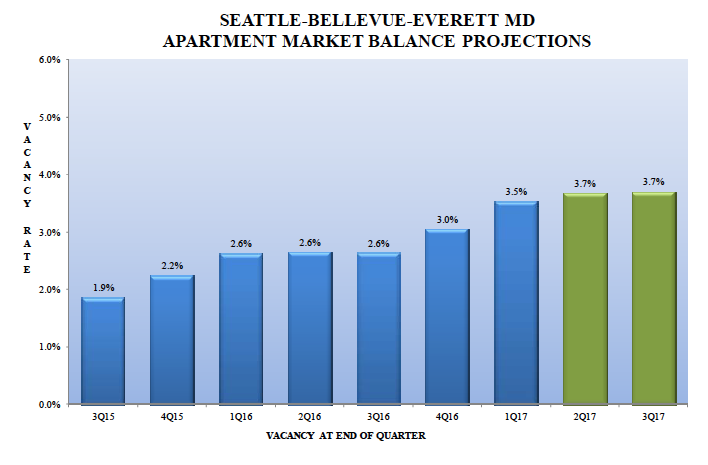Reality Check: Vacancy Rates Will Change but Remain Low in Seattle
We’re in the middle of the projections in a 2015 market study by the O’Connor Group (OCG) that I’m posting this week. I don’t have the latest annual survey data yet. But it’s worth looking at these projects as we move into 2017. Studies like the one OCG produced here are everywhere. This is not shocking information to people who invest in the future of Seattle’s housing market. What does the City use to project these important housing variables? Old data from the United States’ decennial census and survey updates.
What investors in our market know or believe anyway, is that even though a lot of new projects are coming on line (“Look at all those cranes!) demand is still expected to remain high. This is still a recipe for higher prices. If there ever was a time to encourage, even incentivize, new housing development this is it. If we could some how, through policy changes that encourage more investment in housing, push those vacancy rates higher in 2017 and beyond we’d actually have a salutary effect on price in Seattle. Instead what we’re doing as adding mandates and costs to future supply (which is barely keeping up with demand) and squeezing out a 100 or so units of rent restricted units. And outlying areas will continue to have more supply that Seattle does, a recipe for more outflow of people there instead of here.
Supply And Demand Summary
The table below illustrates our forecast for both apartment supply and demand within each major submarket in the Metropolitan area. Vacancies are expected to increase over the next two years as supply steadily catches up with demand. While there is a significant amount of new supply coming online, demand remains strong, which will hold the vacancy rates below 5% throughout the forecast period. We expect to see increases in the vacancy rate in three of the four submarkets, with the Southend remaining fairly consistent. The apartment market has begun to see the impact of the new supply entering the market. Although demand will remain strong throughout this forecast period, supply will continue to catch up over the next two years, pushing vacancies higher, resulting in a projected vacancy rate of 3.7% by the third quarter of 2017.
The graph below displays the forecasted vacancy rates for the Seattle-Bellevue-Everett MD through the 3rd quarter of 2017. Our model of market balance projections shows that vacancies should increase through the 3rd quarter of 2017 to 3.7%. We estimate healthy household and employment growth from 2015 through 2017, resulting in an estimate of demand of 13,489 units in 2015 and 9,670 units in 2016, and 8,157 units during 2017. The significant amount of new projects that will enter the market in 2016 will allow supply to catch up with demand, resulting in an upswing in vacancies, but vacancies should remain below 5.0% in the face of prolonged demand. The bars colored green in the graph below are primarily forecasted using proposed projects as opposed to projects currently under construction.




